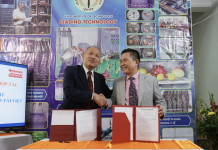Neutralization
Wastewater technology uses neutralization to adjust the pH value. Acids or alkali are added, as required, after processes like precipitation and flocculation, and for the neutralization of industrial wastewaters.
Oxidation/Reduction
Redox reactions are frequently utilized in chemical wastewater treatment and in the treatment of potable water. Oxidation processes with ozone and hydrogen peroxide efficiently remove chlorinated hydrocarbons and pesticides from potable water.
In wastewater treatment, oxidation processes are used to remove difficult biodegradable compounds. Particularly efficient is photochemical purification, which forms hydroxyl radicals from hydrogen peroxide or ozone through UV-light exposure. These Advanced Oxidation Processes (AOP) are used to degrade drug substances like antibiotics, cytostatic drugs, hormones and other anthropogenic trace substances.
In addition, ozone aids in the oxidization of iron and manganese in well water. Reduction processes are required to transform heavy metal ions, for instance, into easily dissoluble sulfides.
Adsorption and Chemisorption
Adsorption is the accumulation of substances on the surface of a solid body, which is a physical process where molecules stick to boundary surfaces through the van der Waal force. If chemical bonding binds substances to the surface of a solid body, the process is called chemisorption. In contrast to adsorption, chemisorption is non-reversible.
Wastewater treatment uses activated carbons to bind soluble water contents that could not be sufficiently removed with lower-priced methods such as biological wastewater treatment, precipitation and flocculation. Colorants from textile dying plants, for instance, often can only be completely removed through adsorption on activated carbon. Anthropogenic trace elements such as pharmaceutical residues and polar organic substances like adsorbable, organically-bound halogens (AOX) also bind to activated carbon.
Doped activated carbon can also be employed to remove arsenic and heavy metals. Granulated iron hydroxide is another ideal agent to remove toxic metalloid arsenic from potable water, contaminated ground water and industrial wastewaters. In this process, the iron hydroxide reacts with the arsenate ions to form iron arsenate. This method is efficient as well as cost-effective.
Precipitation
Precipitation is a chemical process that separates a previously soluble substance from a fluid. A common method is to create a precipitation reaction by adding suitable agents. Through precipitation, heavy metals, for instance, transform to not easily soluble metal hydroxides. Other situations may require precipitation to carbonates or sulfides.
Anions can often be precipitated as calcium, iron, and aluminum salts. The separation of fluoride ions, for instance, is achieved through precipitation with milk of lime. During wastewater treatment in the treatment plant, adding salts like iron(II) sulfate, iron chloride or aluminum chloride lowers the phosphate concentration. The phosphate precipitation can either be integrated as simultaneous precipitation into the biological treatment stage or added as a subsequent separate process step.
Flocculation
Flocculation prepares very fine particles that are present either suspended or in the form of colloidal solutions, for removal from water. If the surface charge of this very fine particulate matter is the same, the particles cannot, due to mutual electrical repulsion, accumulate to larger agglomerates.
In this case, suitable chemicals, flocculants and flocculation aids help achieve the agglomeration of such particulate matter, creating macro flakes that sediment. Flocculation is used to improve settling properties as well as to drain sewage sludge. Employing iron and aluminum salts for flocculation allows the flocculating of phosphate at the same time.
Ion Exchanger
Ion exchangers are materials that can replace the ions of one solution with other ions. The cation exchanger, for instance, replaces calcium ions with sodium ions. Once the ion exchange is exhausted and the calcium ions are completely saturated, the ion exchanger needs regeneration.
This success of this process is based on the principle of displacement: the higher the ions’ charge, the stronger the ion-binding to the ion exchanger. If both types of ions are charged the same, the one with the larger radius will be the one with the stronger ion-binding force. During the ion exchange process, the stronger-binding ion will displace the lesser-binding ion.
Ion exchangers are suitable for the removal of heavy metals and anions and are therefore often used as ‘policing filters’ after precipitation and flocculation. In addition, they assist with water softening, changing the water’s salt content, and water desalination; particularly important for the semiconductor industry that uses them to produce extremely clean, demineralized water known as ultra pure water.
*source: das-ee.com














